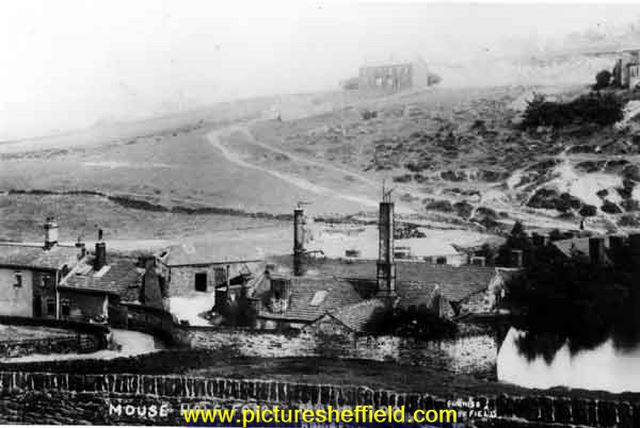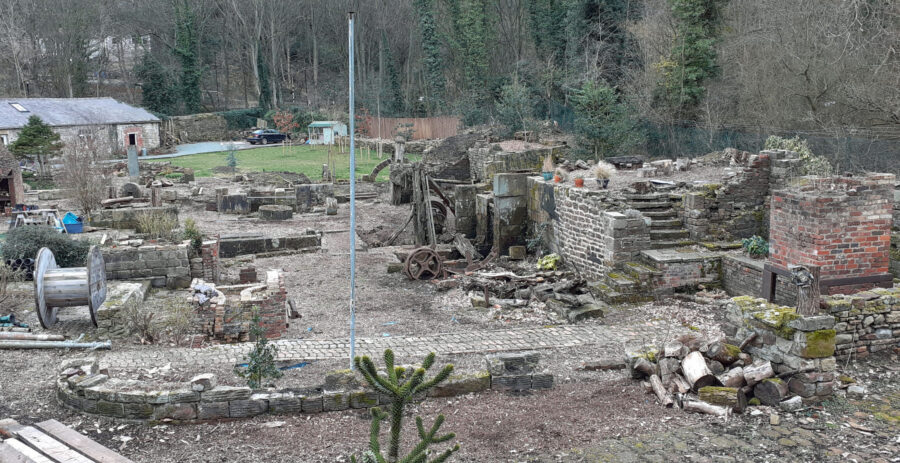
Introduction
Mousehole Forge dates from at least 1628, when there were two lead mills and a farmhouse that incorporated a small cutlery workshop. The lead mills were later converted to an iron forge making items such as iron bars, vice-legs and sledge-hammers, and by the end of the 18th century Mousehole had become famous throughout the world for producing anvils. The forge closed in 1933 and fell into ruin until the 1980s, at which time Sheffield City Council sold the site into private ownership.
The main site now comprises the remains of the forge complex, including the remains of the surviving timber belly-helve hammer and a puddling furnace, together with the house (still occupied) and a long, low building that was a workshop/store (converted to dwellings in 2020).
Mousehole Forge is on private land, but some of the forge remains can still be seen from outside the gates
The main gates of Mousehole Forge. Photos: Sue Shaw, 2016
History (c. 1620s–1930s)
Main trades: Lead mill (smelting), cutlers’ forge, iron forge (including iron bars, vice-legs, sledgehammers, anvils).
The Mousehole Forge site dates from at least 1628, when there were two lead mills (‘smelting houses’), and a farmhouse (part of the present house) that incorporated a small cutlery workshop. By 1664 the lead mill had been converted into an iron forge. This was included in the national list of ironworks in 1717, at which time the annual production of iron bars amounted to some 60 tons, converted from blast furnace pig-iron.

By the end of the 18th century the forge was producing the anvils for which it became famous throughout the world. Anvil making as an industry started at Mousehole Forge, which for over a century (possibly two), is thought to have been the only works of its kind in the world. It was the first to specialise in anvil making and to make any attempt at standardising the shapes of anvils used for different purposes. The anvils won much acclaim and were awarded a gold medal at the 1851 Great Exhibition at Crystal Palace. There is a Mousehole anvil (date unknown) in one of the marriage chapels at Gretna Green. Mousehole was one of the leading exporters to the USA for many years and hundreds of Mousehole Forge anvils, much sought after by collectors, are still available there.
There is even a dedicated Facebook page for people interested in the anvils made at Mousehole Forge. Brett Payne (Sheffield designer–silversmith) has written an interesting article about the history of Mousehole anvils.
In the early 19th century, three more waterwheels were built, giving a total of four: two breast-shot wheels powering forge hammers, and two overshot wheels powering a furnace-blower and grindstones for finishing anvils. Extra air for the furnaces was supplied via cast-iron pipes from the Grogram Wheel (next downstream) in the mid-19th century, which meant that more water was available for use at Mousehole to power the hammers and grinding wheel.
Along with vice-legs and sledgehammers, anvils were made using water-powered hammers until 1933, when the forge closed. Parts were demolished in the 1940s and the site fell into ruin until the 1980s, at which time Sheffield City Council sold the site and restoration work has subsequently been carried out by the various owners.
The remnants of the former forge complex are considered to be of national significance and are designated as Scheduled Ancient Monument (SY1284); the workshop range is Grade II listed. Further details of these, and other listed buildings in the valley, can be found on the Historic England website .
What's there now
The main Mousehole Forge site comprises the derelict remains of the forge complex, including a puddling furnace.

The huge oak log, over 22 ft long by nearly 3 ft in diameter, is the remains of a hammer helve. The house was renovated and is now occupied. The long, low building that was a workshop/store was converted to dwellings in 2020. The main site itself is privately owned. The block-stone weir is slightly curved and still in good condition. Large stone blocks mark the entry to the short head goit, which now leads into a shallow channel along the bottom of the steep hillslope.
The drained mill dam is well wooded. The massive stone blocks that are the remains of the overflow sluice can be seen by the side of the trail – this is a good example of a double-overflow with a central draining hatch. Another can be seen at Malin Bridge, beside the Burgon and Ball building. Water from the overflow was culverted beneath the path and out into the river through an arch in the stone-work. The tail goits are culverted under the path and flow into the river through arches in the river wall just above the Grogram weir. The third arch, which can be seen in one picture, is presumably now hidden in the river bank. Just upstream of Mousehole/Racker Way bridge, look for a small area of tipped metallic slag that forms part of the river bank. There are also some small lumps of slag protruding from the path near there.
Nature and wildlife at Mousehole Forge
The mill dam at Mousehole was one of the largest in the valley but since the forge closed in the 1930s the mill dam has become well-colonised by trees such as Ash, Alder, Elder, Sycamore, Holly, Hawthorn, Elm and Willow. Look and listen out for birds such as Blackbird, Nuthatch, Chiffchaff, Robin, Thrush, Wren and tits including Blue, Great and Long-tailed. Dippers and kingfishers can sometimes be seen on this stretch of river.
![riv_mf_03 Mousehole overflow sluice with wooded mill dam behind. The mill dam has become well-colonised by trees such as Ash, Alder, Elder, Sycamore, Holly, Hawthorn, Elm and Willow. [Photo: Sue Shaw, June 2015]](https://rivelinvalley.org.uk/wp-content/uploads/2021/02/riv_mf_03-900x463.jpg)
Art at Rivelin - Mousehole Forge
Its easy access from the tram terminus at Malin Bridge made Mousehole Forge and its mill dam a favourite subject with the Rivelin Valley Artists. Ben Baines always described this view as one of his “pot-boiler watercolours” and could always find a buyer – there must be many versions of the scene hanging on walls in Sheffield and beyond.

Location
Mousehole Forge is located on the north side of the river near to Malin Bridge, between Rivelin Valley Road and Stannington Road, across the river from the Rivelin Fire Station.
The forge site is privately owned, but the mill dam area is owned by Sheffield City Council and there is open access. A public bridleway passes the site, easily accessed from both Stannington Road and Rivelin Valley Road.
A marker post installed at the site by Rivelin Valley Conservation Group gives a brief history and links to this website.
Grid reference: SK 3246 8905
Nearest postcode: S6 5FF.
